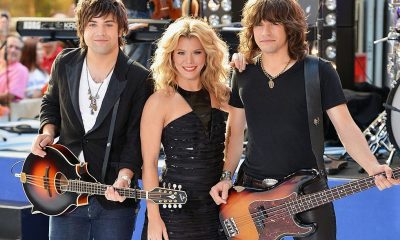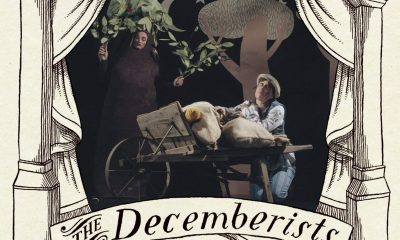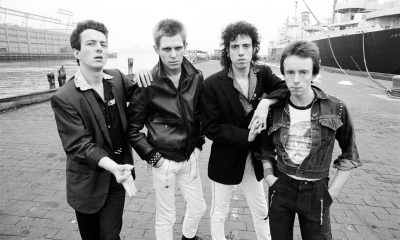Columns
The Noise Beneath The Apple: Meet Luke Ryan, The Queens Cowboy
They come from all parts of the planet and bring their life experiences, their inner artistic wares, to the Big Apple. They are the buskers and subway singers of the New York underground.
Meet Luke Ryan, who has been playing the underground for over thirty years. To date, he boasts in the neighborhood of over $12,000 in fines from the New York Police Department and the Transit Police for his performances. That’s just a rough estimate, of course. “I’ve never paid one,” he says, “but I think they’re about fifty bucks a pop. I have a couple cigar boxes full.”
The tickets are not because his performances are bad, but, because he performs at all.
Luke is a native New Yorker, although “Everybody thinks I’m a honky-tonk band born on the back of a Greyhound bus. But I’m a Queens Cowboy,” he says.
Ryan is a hard living singer/songwriter, part Waylon Jennings, part Kris Kristofferson and all original Luke. He begins by telling me that about fifteen years ago, he was on a bus heading to Wyoming to do a Vision Quest. Being Native American, my interest is immediately piqued. Vision Quest is a sacred ceremony. It’s a rite of passage; a turning point taken to find oneself and ones spiritual direction.
“Did you do the Vision Quest,” I ask. “And what was your power animal? What did you see,” my questions hammer at him.
“Yeah, I did it. My power animal was the Twinkie, because after a day of not eating, I started hallucinating about Drake’s Cakes, Then the Ring Ding came by on a buffalo.”
We laugh together and I realize that I may have met the Emperor of the Mad Ones.
“No, it was weird,” he continues. “Because I was expecting the whole Carlos Castaneda thing. Pure, vivid, non-drug induced hallucinations. But, it taught me to slow down and it taught me to listen to things. That was harder than not eating. It was that gripping feeling of having nothing to do and being outside of time. I would go, ‘Jesus, it’s got to be noon and I should be getting this or that done.’ It was a really good exercise to slow everything down.”
Luke had gone to a school of art and design, and had become an illustrator. He got married, became a father and got divorced, all by the ripe old age of 25. He then found himself ‘newly wild’ in New York City in the 70s. And it was there that Luke got his start as a musician…which would eventually lead to the subways.
“So, here I was—never having really sowed my oats. And I end up doing this open mic night in the Village. There were about four or five places, and you would go and you’d pick time slots to play. You could play at Folk City at 8 and then your next time slot would be at 10 at The Bitter End, so you’d be bouncing around and getting drunk and getting stoned in all that time. So, when you played at Kenny’s Castaways at two in the morning, you weren’t making much sense, and sometimes those were the best. Then I realized that you could meet more chicks playing guitar, running around and getting into trouble. So, I started doing that. Then I started thinking, I’d really like to make my living as a musician. How do I do that?”
How he did that began at Columbus Circle, the major transportation hub of New York at the intersection of Broadway, Central Park West, Central Park South and 59th Street. The circle itself displays a monument, created by Italian sculptor Gaetano Russo, to commemorate the 400th anniversary of Columbus’ first trip to the Americas. Columbus Circle has been featured in tons of movies: The Devil Wears Prada, Taxi Driver, Die Hard with a Vengeance, and if you remember the movie Ghostbusters, it is also the site where the Stay Puff Marshmallow Man begins his trek towards Central Park.
“When I first started playing, I met this guy, Jonathan Best. He was a very accomplished keyboard player and funky, too. We started a duo called Hot Duck Sauce. We were smoking some really strong herb in Rocklin City, sitting in the car and discussing what we were gonna call our band and we were eating Chinese food and I said, ‘Pass me the duck sauce’.”
The newly formed duo took on Columbus Circle in the early 80s. Dirty, dangerous and destitute. Pimps, hookers and drug dealers owned the night. Vagabonds, homeless and the derelict owned the day. This was the backdrop for Luke’s foray into the world of busking.
“We rented a Spinet piano, and every morning we’d put the piano on a little dolly with the guitar and amp and push it out onto Columbus Circle. And then all the homeless guys who lived there ultimately became part of the act, because we were playing in their living room. So, as soon as we’d hit the first note to “My Girl,” Lonnie would get up, stumble over to the mic and start singing…whether we wanted him to or not. It was just crazy. People would sit there and watch us because it was such a hoodlum circus. There were fights, women tearing off their tops. That crazy early 80s time. And I met Tom Waites, back in the day, with Jonathan and the piano and the homeless guys dancing around. He was in the crowd, just watching. I ran over to him and gushed all over him and he came over and hung out for awhile. Columbus Circle, man. That’s my power place. The Ugly makes good songs.”
In time, Luke and Jonathan went separate ways and Luke ventured into the Underground.
“I bought all my equipment and I went out there and I set everything up in the subway and I looked at everyone and I just froze, like a deer in the headlights. So, I packed all my stuff up and went home. But, my girlfriend was home and she had other ideas. She said, ‘we spent next month’s rent on all this. You’re going back out there’.”
And so he did. And he stayed out there. And thirty years later, he’s still out there.
Busking may sound easy. It may sound bohemian. It may even sound romantic. But playing the subways is hard work. First, there are the elements. In New York City, there is heat and humidity the likes of which Stephen King would be hard pressed to do justice to. And this alien type of condition takes over the city for at least three months.
Then there’s the cold. It starts out just chilly and then quickly escalates to freaking frigid. At about 15 degrees above zero, New York City landlords finally turn on the heat and New Yorkers have their last rooftop cookout. This happens in about October.
And in the subway, these elements are compounded by degrees in either direction.
Then there are those who are, as my mother would say, ‘a sandwich shy of a picnic’. These are the folks who add spice to any buskers day.
“A couple of years ago,” Luke says, “I was playing and I see this young guy. He doesn’t have any shoes or shirt on and it’s October, so it’s kinda cold. He stands in front of me and I look up and he smiles. Then he takes his lighter out and I think he’s gonna do that stale joke about being in a concert. Then he bends over and catches my money on fire. So, I jump into my guitar case, stomping out my money and cursing him. I look at him and he gives me a big smile and takes these mayonnaise packets out, rips ‘em open and puts them through his hair, flashes me a peace sign and walks away.”
And then, of course, there’s the NYPD.
“So, I’m getting chased by a cop,” begins Luke. “I had a shoebox full of tickets and this cop was really enjoying moving me and I look up and I see Abbie Hoffman, and it was right after he came out from the underground. And he was just checkin’ it out. So the cop leaves, and Abbie Hoffman comes by and he says, ‘Does this happen often?’ And I say, ‘Yeah’, and I smile and say, ‘Great seeing you again Abbie.’ And he goes, ‘Oh, you know who I am?’ And he gave me a little button that I still have today—it says, “Go Fuck the Establishment.”
And then there’s the simple fact that times are changing.
“It’s getting hard to make a living out there,” Luke explains. “Everyone says it’s the economy and sure that’s part of it, but there’s something that’s been going on with people underground for a couple of years now, and I see it related to the rampant new technology. People are plugged into their iPods, MP3s, whatever. And even if they’re not physically plugged in to something, they’re plugged out of life. It’s like they’re not there anymore. Once in a while you see somebody, and they’re not plugged out and you feel such a kindred spirit. And then the next week you see them and they’re zombified, like that movie with the pods; Invasion of the Body Snatchers.”
Despite all these trials and tribulations, the buskers remain. And they play.
“It’s funny,” Luke says. “When I play the shuttle, where you saw me [42nd Street/Grand Central], I have a full scope of the social environment of New York. It’s about 8 am when I’m there setting up, and I see all the true blooded New Yorkers—the immigrants and the blue collar workers heading off. They have lunch boxes and they don’t have a lot of money. They’re working for a wage, and I get a really good vibe. Then, at about nine, the 9-5 working stiff is there, and they relate to my music. And then, about ten, it gets weird. The first Starbucks cups make their appearance. From about 10 on, the Starbucks cups get bigger, and when the biggest Starbucks cup makes its appearance, the day is pretty well done. When I see all the copies of the Wall Street Journal piled in the garbage pail next to me, we’re screwed. I know that’s it.”
A pivotal point in the psyche of this city occurred on the morning of September 11th, 2001. The world, the United States and New York City, would never be the same.
“When things got really bad during 9/11, everyone rallied,” Luke remembers. “That whole period was strange because everyone was in shock. And, at some point, I realized, ‘I’m gonna have to go back and play.’ Because that’s what I do. One day, I took my guitar and went to Penn Station. I was playing there, and I see a cop come by and it was weird because you didn’t know what you should do. And I thought he’s gonna chase me and maybe he should, maybe this is not appropriate—and he dropped a buck and he goes ‘Thanks for being here man. We need this. Can you do that Springsteen song again?’ And after awhile, it became one of the best times playing, because everyone really did need it. It felt good. People needed that connection.”
“Then the iPods came.”
- Lists13 years ago
Top 10 Country Music Albums of 2010

 Interviews5 years ago
Interviews5 years agoJohn Rich – The Interview

 Song Reviews16 years ago
Song Reviews16 years agoTaylor Swift – “Love Story”

 Interviews5 years ago
Interviews5 years agoHoneyhoney on Hiatus: Revisit our 2008 Interview with Suzanne Santo

 Album Reviews14 years ago
Album Reviews14 years agoAlbum Review: Miley Cyrus – Can’t Be Tamed

 Song Reviews6 years ago
Song Reviews6 years agoThe Band Perry – “Hip To My Heart”

 Columns5 years ago
Columns5 years agoThe Link Between Folk Music’s Past and Present

 Columns5 years ago
Columns5 years agoIs Marketing Killing Rock and Roll?



